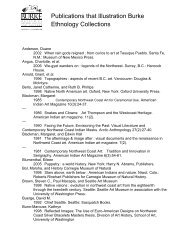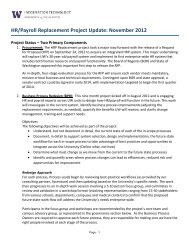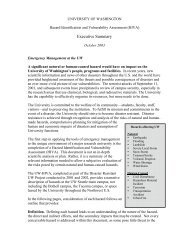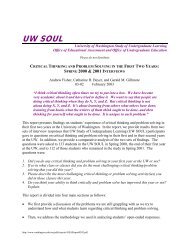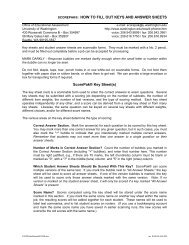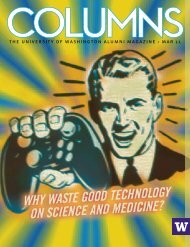UWPD Strategic Plan 2012 - University of Washington
UWPD Strategic Plan 2012 - University of Washington
UWPD Strategic Plan 2012 - University of Washington
- No tags were found...
Create successful ePaper yourself
Turn your PDF publications into a flip-book with our unique Google optimized e-Paper software.
<strong>UWPD</strong>STRATEGICPLAN<strong>2012</strong>
Our MissionThe <strong>University</strong> <strong>of</strong> <strong>Washington</strong> Police Department actively collaborates with ourcommunity to create a safe and secure campus through education, problemsolving and enforcement. We use innovative practices, continuing training andpartnerships to provide pr<strong>of</strong>essional public safety services, thereby reducingcrime and the fear <strong>of</strong> crime. In doing so, we foster and maintain an environmentthat supports the well‐being <strong>of</strong> our students, staff, faculty and visitors.Our VisionThe <strong>University</strong> <strong>of</strong> <strong>Washington</strong> Police Department aspires to be a world leaderin innovative campus public safety practices.Our commitment to excellence supports the campus community’s pursuit <strong>of</strong>academic and research goalsin an environment free <strong>of</strong> crime and the fear <strong>of</strong> crime.Safeguarding the Academic Community with P.R.I.D.E.
TABLE <strong>of</strong> CONTENTSIntroduction from the <strong>Strategic</strong> <strong>Plan</strong>ning Committee<strong>Strategic</strong> IssuesReduce Fear and Build CommunityCommunication and AwarenessSupervisor ConsistencyMoraleFight CrimeInvestigative ProtocolsEmployee TrainingIncrease EfficiencyTechnologyPolicy and Accreditation ManagementStaffingFuture ObjectivesAcknowledgmentsAppendix: Definition <strong>of</strong> Terms
INTRODUCTION from the STRATEGIC PLANNING COMMITTEEA cross section <strong>of</strong> the <strong>University</strong> <strong>of</strong> <strong>Washington</strong> Police Department beganmeeting in August <strong>of</strong> 2011 to develop the <strong>UWPD</strong> <strong>Strategic</strong> <strong>Plan</strong>. Commissionedand civilian, front line workers and management, longtime employees andnewcomers, our committee sought to broadly represent the department.Our directive:• Revisit our mission, vision and values, and update if needed• Reach out to stakeholders, assess their needs to include their priorities inour strategic initiatives• Identify the strengths, areas <strong>of</strong> growth, opportunities and threats facingthe department• Prioritize departmental goals• Identify issues to tackle in the coming year• Identify first year success indicators• Put a process in place to follow up on our strategic planFrom August through December, the committee worked to accomplish its tasksby meeting with stakeholders, breaking into subcommittees and gathering data.We are proud to present our final product, the <strong>UWPD</strong> <strong>Strategic</strong> <strong>Plan</strong>. Now comesthe challenge <strong>of</strong> implementation, assessment and revision over the next year,five years, ten years!We will know our plan has been a success when we…Reduce crimeIncrease the perception <strong>of</strong> safetyStrengthen our community relationshipsRespectfully submitted,The <strong>UWPD</strong> <strong>Strategic</strong> <strong>Plan</strong>ning Committee
STRATEGIC INITIATIVE: Communication and AwarenessOpen and clearly defined lines <strong>of</strong> communication with our community can reduce concernsrelating to crime and the fear <strong>of</strong> crime on the university campus. Serious community problemscan be affected through a community effort involving police, administration, students, facultyand neighborhood partners, all <strong>of</strong> whom are <strong>UWPD</strong> stakeholders. Community partnershipscan be further enhanced and crime can be reduced by building upon existing strategies thatpromote the <strong>UWPD</strong> and our services to our community.Alignment with Student Life Pillars: Engagement, Student Learning, Access, CareNeeds:Provide clear and effective lines <strong>of</strong> communication with our community to buildrelationships and thereby reduce crime and the fear <strong>of</strong> crime.Annual Goals:Continue with current projects (marketing <strong>UWPD</strong> services, increasing Facebook pageusage, community outreach efforts, etc.), and launch into goals delineated below inthe future.Annual Success Indicators:Increased awareness and usage <strong>of</strong> <strong>UWPD</strong> services.Future Goals:1. Identify critical stakeholders and their communication needs.2. Evaluate current communication methods and make recommendations forimprovement.3. Incorporate innovation and new communications technology as needed.4. Evaluate our current level <strong>of</strong> participation in law enforcement groups,organizations and committees for proper exposure and relationship building.5. Creation and implementation <strong>of</strong> a department‐wide communication plan.6. Actively search out participation with community groups, other law enforcementagencies and others.7. Institute a marketing initiative that encourages and increases use <strong>of</strong> existingcommunication tools (Tip Line, WatchDawg, Timely Warning, <strong>UWPD</strong> Facebook andWeb site) and promotes new opportunities.8. Create an innovative customer service data collection tool to evaluate our serviceobjectives.9. Enhance and increase use <strong>of</strong> social media opportunities and web communicationtools.
STRATEGIC INITIATIVE: Supervisory ConsistencyDecision‐making by first level commissioned supervisors require guidelines to enhanceconsistency among the responses <strong>of</strong> sergeants to specific patrol situations. Providing tools tosupport consistency improves morale and allows us to provide excellent services to thecommunity.Alignment with Student Life Pillars: CareNeeds:Consistency in decision making and guidance given by supervisors.Annual Goals:1. Evaluate where the inconsistencies lie within first‐line supervisors and identify thereason for inconsistencies.2. Create training curriculum for first line supervisors and mid‐level managers in aclassroom and web‐based learning environment specific for <strong>UWPD</strong> (to includefollow up training and mentoring).3. Update standard operating procedures specific to first line supervisors.4. Determine what, if any, additional training is needed.5. Determine what tools are needed for improved supervisor consistency (e.g.,performance evaluation s<strong>of</strong>tware/templates, user‐friendly policy manuals).6. “Mini‐camp” training provided for all sergeants and lieutenants and civiliansupervisors as appropriate.Annual Success Indicators:Increased consistency in employee evaluations and decision‐making among first‐linesupervisors.Future Goals:1. Identify and implement ways to support supervisors in use <strong>of</strong> performancestandards and expectations in consistent manner.2. Create tools for improved supervisor consistency .3. Provide training as needed.4. Create a succession plan.5. Use succession planning to create smooth transitions and effective on‐the‐jobtraining for new supervisors.6. Consistent and systematic responses to situations by first line supervisors and addsuch procedures to Standard Operating Procedures.7. Provide opportunities, encouragement and resources for pr<strong>of</strong>essional growth.
STRATEGIC INITIATIVE: MoraleThe <strong>University</strong> <strong>of</strong> <strong>Washington</strong> Police Department members do our jobs in the mostpr<strong>of</strong>essional manner every day, and those who deliver above and beyond the normal scope <strong>of</strong>their position are recognized for outstanding work. We strive to treat everyone equitably. Byproviding a workplace free <strong>of</strong> negativity, we increase the effective and efficient use <strong>of</strong> ourresources.Alignment with Student Life Pillars: Care, Engagement, DiversityNeeds:Positive, respectful work environment that encourages hard work and continuous selfimprovement.Annual Goals:1. Provide clearly defined Vision, Mission, Values. Create Vision/Mission/Values postersand post in our buildings and articulate at meetings, in particular our annual openmeeting2. Work on other <strong>Strategic</strong> Initiatives that affect morale (for first year, see specifically,Supervisor Consistency, Investigative Protocols and Technology).Annual Success Indicators:Increased involvement in department activities – pr<strong>of</strong>essional and social.Increased use <strong>of</strong> department fitness center or obvious involvement in a fitness program.Complaints accompanied by recommended solutions.Continued investment and involvement in the <strong>Strategic</strong> <strong>Plan</strong>ning process.Future Goals:1. Clarify departmental expectations and model how to interact with one another:Internal‐External, Supervisor‐Subordinate, Co‐worker‐Co‐worker.2. Resolve issues at the lowest level and with those directly involved. Makerecommendations on the types <strong>of</strong> issues to be dealt with by first‐level supervisorsversus Internal Affairs, etc.3. Create a voluntary health & wellness program with incentives for those who meetfitness standards.4. Emphasize effective ways <strong>of</strong> recognizing employees.
STRATEGIC INITIATIVE: TechnologyThe right technology with the proper training used for the right reasons can significantly affectcrime and the fear <strong>of</strong> crime. By reviewing the technology (hardware and s<strong>of</strong>tware) that wecurrently use, we can identify technology and develop a 5‐ and 10‐year technology plan tohelp decrease crime and the fear <strong>of</strong> crime more efficiently and effectively.Alignment with Student Life Pillars: Organizational Efficiency, AccessNeeds:Use <strong>of</strong> technology that enhances organizational efficiency and effectiveness.Annual Goals:1. Maximize use <strong>of</strong> currently owned s<strong>of</strong>tware.2. Create a comprehensive and cohesive 5‐ to 10‐year technology plan.3. Identify a decision‐making process for purchasing new technology.4. Evaluate current s<strong>of</strong>tware technology for capabilities before purchasing mores<strong>of</strong>tware.5. Develop a technology replacement plan and schedule.Annual Success Indicators:Efficient response time. Consistently meeting or beating response time goals.Increased and more timely information sharing, internally and externally.Consolidated technology system (efficient use <strong>of</strong> hardware and no duplication ins<strong>of</strong>tware).Higher technical pr<strong>of</strong>iciency with lower total costs.Systems easier/more efficient for users.Enhanced purchasing capability when funding is available.Future Goals:1. Identify process for “test‐driving” new technology.2. Keep a knowledge base <strong>of</strong> emerging trends and technology changes. Look for scalablesystems that can increase/decrease as needed.3. Create knowledge base and tracking system for emerging trends.4. Implement procedure for retention <strong>of</strong> information/knowledge so we are preparedwhen money is available to buy.
Fight Crime
STRATEGIC INITIATIVE: Investigative ProtocolsTo provide effective police services to the community we serve, the <strong>UWPD</strong> has a highlytrained, efficient and effective cadre <strong>of</strong> commissioned <strong>of</strong>ficers prepared to perform basic aswell as complicated criminal investigations. All commissioned <strong>of</strong>ficers are competent incriminal procedure and investigation so that initial reports are investigated to the fullestextent. To that end, we have investigative practices, protocols, procedures and processes inplace, and ensure that those tasked with these responsibilities are trained in fundamentalcriminal investigation. Our protocols are in‐line with local, state and federal guidelines and“best practices” for successful criminal investigations.Alignment with Student Life Pillars: CareNeeds:To provide rigorous follow up on investigations from initial report through final casedisposition.Annual Goals:1. Evaluate current investigative standards, processes and protocols at <strong>UWPD</strong>.2. Assess investigative training requirements; make plans for proper training to beprovided to all personnel.3. Ensure reports are well written with all necessary elements and facets <strong>of</strong> a criminalinvestigation. Ensure complete and thorough content in all reports.4. Conduct Quality Assurance audits <strong>of</strong> cases to ensure we are conducting thorough andcomplete investigations. Reports will be reviewed by supervisors with adjustments andcorrections made to ensure investigative practices are followed.5. Increase interaction with other law enforcement agencies for collaboration andincreased understanding <strong>of</strong> prosecutor expectations.Annual Success Indicators:Decreased investigative flaws in reportsBetter, more thorough reportsIncrease in successful prosecutions on criminal casesDecrease in clarification questions from Prosecutor’s <strong>of</strong>fice
STRATEGIC INITIATIVE: Investigative ProtocolsFuture Goals:1. Ensure our practices are in‐line with the standards and protocols for proper criminalinvestigations. Increase awareness on “best practices.”2. Continue to develop <strong>UWPD</strong> Investigative standards and protocols.3. Confirm that all commissioned personnel are properly trained and equipped for basiccriminal investigations.4. Ensure our detectives and investigative personnel are trained for more complexcriminal investigations through continuing education.5. Ensure that investigative personnel have the proper tools to successfully perform theirexpected function (technology, matrices, checklists and other tools).6. Partner with our surrounding law enforcement agencies: ensure we have the necessarymutual aid agreements in place should the need arise; train with our partners to betterhone investigative skills and experience and to increase collaboration.7. Develop procedures for addressing shortcomings and successes (i.e., remedial training,system for identifying need for remedial training, personnel recognition for job welldone).8. Sustain readiness by providing on‐going investigative training.9. Continue to evaluate our success by reviewing investigations and reports for potentialimprovement.
STRATEGIC INITIATIVE: Employee TrainingTo provide effective police services to our community, the <strong>UWPD</strong> recognizes that it isimportant to ensure that the training our personnel receive is consistent with currentstandards and practices in the pr<strong>of</strong>ession and that the training is specific to the role ourpersonnel play at the <strong>University</strong> <strong>of</strong> <strong>Washington</strong>.Alignment with Student Life Pillars: CareNeeds:Maintain a training program that supports the pr<strong>of</strong>essionalism <strong>of</strong> the department.Annual Goals:1. Ensure that each employee has a pr<strong>of</strong>essional development plan in place.2. Ensure that non‐mandatory training ties to employee development plans and has abenefit to the <strong>University</strong> <strong>of</strong> <strong>Washington</strong> community.Annual Success Indicators:Efficient use <strong>of</strong> financial resources for training.Increased efficiency in scheduling training.
STRATEGIC INITIATIVE: Employee TrainingFuture Goals:1. Evaluate organizational training needs (content) on an annual basis, keeping currentand emerging trends in mind. Develop and implement training review program.2. Evaluate current standards <strong>of</strong> training at <strong>UWPD</strong> and all current in‐house trainingprograms. Look at what training is provided from outside vendors or sources, andassess how/if we can bring the training in‐house.3. Evaluate the programs we teach, and the people who are instructors to ensure success.Create a process for evaluating instructors and for providing the support/training toinstructors for their further improvement. Ensure our instructors and trainingprograms are <strong>of</strong> the highest quality possible within the pr<strong>of</strong>ession.4. Assess the feasibility (cost/benefit) <strong>of</strong> training in‐house trainers. Determine whattraining we can efficiently and effectively provide on‐site.5. Provide on‐going opportunities for quality trainings to ensure department personnelare current with best practices in campus policing.6. Train <strong>UWPD</strong> trainers in areas that will maximize efficiency and effectiveness <strong>of</strong> trainingdelivery. “Build the bench” <strong>of</strong> our in‐house training cadre.7. Share our cadre <strong>of</strong> well‐trained trainers with others in the pr<strong>of</strong>ession by hosting on‐sitetraining for other agencies.8. Informal mentoring encouraged and addressed during on‐the‐job training for newsupervisors.9. Explore a formal mentoring program.10. Look for every opportunity to enhance and enrich our training programs to ensureadequate employee development within individual pr<strong>of</strong>essional development plans.
IncreaseEfficiency
STRATEGIC INITIATIVE: Policy & Accreditation Management<strong>UWPD</strong> meets law enforcement “best practices” relating to crime, the fear <strong>of</strong> crime. Weoperate efficiently and effectively through the Commission on Accreditation for LawEnforcement Agencies® (CALEA), an international organization. CALEA provides us withminimum standards and guidelines; <strong>UWPD</strong> creates policies applicable to our agency to meetthose standards and guidelines by embedding the culture <strong>of</strong> accreditation into theorganization so that every action we take is consistent with our policies.Alignment with Student Life Pillars: AccessNeeds:Full compliance with CALEA and best practices standards for the <strong>UWPD</strong>. Fullcompliance with all other external mandates (e.g., <strong>Washington</strong> State Patrol Access, Clery,Revised Code <strong>of</strong> <strong>Washington</strong>).Annual Goals:1. Create efficiencies in the policy review/acknowledgement process via technology.2. Increase involvement at all levels in the agency in the accreditation process.Annual Success Indicators:Pro<strong>of</strong>s <strong>of</strong> compliance consistently provided by staff rather than Accreditation Manager.Policy review allows for easily locating systemic issues and allows for correcting orimproving the policy.Effective and efficient use <strong>of</strong> department resources in complying with <strong>UWPD</strong> policy andprocedures.Future Goals:1. Create and implement a clear plan for collecting pro<strong>of</strong>s <strong>of</strong> compliance.2. Create a clear and concise process map through policy and procedure review andrevision.3. Revise internal Clery reporting collection procedures.4. Design a “Command Inspection Program” for unit supervisors (Lts, Sgts, Mgrs). Thisprogram acts as an assessment tool, giving Command Staff a snapshot <strong>of</strong> how each unitis functioning.5. Develop a lesson plan for training all personnel on collecting and providing pro<strong>of</strong>s.6. Train all personnel in the process <strong>of</strong> collecting/providing pro<strong>of</strong>s <strong>of</strong> compliance.7. Supply staff with an efficient way to furnish pro<strong>of</strong>s <strong>of</strong> compliance.8. Complete, approve and implement Unit Supervisor “Command Inspection Programs.”
STRATEGIC INITIATIVE: StaffingAdequate staffing is necessary to carry out the mission <strong>of</strong> the <strong>UWPD</strong>. Overtime, shiftadjustments and temporary assignment changes continue to be necessary to fulfill ourobligations. The <strong>UWPD</strong> strives to deploy the resources in the best possible manner. The <strong>UWPD</strong>also seeks to find new resources, such as interns, part‐time employees, students and/orvolunteers, to aid departmental efficiency.Alignment with Student Life Pillars: Access, Care, Student Learning, DiversityNeeds:Appropriate staffing levels based on job task analysis.Annual Goals:Due to current vacancies, this initiative will be implemented in 2013.Future Goals:1. Initiate a job task analysis for all positions.2. Initiate an internal study <strong>of</strong> use <strong>of</strong> leave and scheduling efficiency.3. Make recommendations on scheduling and use <strong>of</strong> leave.4. Investigate the use <strong>of</strong> student employees as <strong>UWPD</strong> resources. Determineeffectiveness <strong>of</strong> a student employee deployment strategy.5. Determine the supervisory needs for the security guard program.Success Indicators:Reductions in schedule conflicts.Reduced overtime for shift coverage.Meeting or beating response time goals for patrol and detectives.Measured effective response to needs <strong>of</strong> our campus community done via triennialCrime Prevention Quality Assurance Surveys and meetings with the CampusSecurity Advisory Committee.
FUTURE OBJECTIVESIn identifying the <strong>Strategic</strong> Initiatives for the <strong>UWPD</strong> <strong>Strategic</strong> <strong>Plan</strong>, the committeenoted multiple challenges to be addressed under each initiative. The committeeprioritized the challenges, and this plan tasks the department with addressingparticular challenges and issues in the first year. In the following years, thedepartment will tackle the other challenges noted in this document that werenot addressed in the first year. The committee recognizes that these goals andobjectives are fluid and may change depending on internal and externalcircumstances and needs.The department will review the <strong>Strategic</strong> <strong>Plan</strong> on a regular basis to measure ourprogress on the assigned initiatives and to prioritize tasks for the coming yearthrough the use <strong>of</strong> subcommittees. Each year, the committee will revisit theinitiatives to determine their continued relevance and identify any new issues orchallenges that may have developed over the year.
ACKNOWLEDGMENTSThe <strong>UWPD</strong>’s <strong>Strategic</strong> <strong>Plan</strong> resulted from the collaborative efforts <strong>of</strong> the <strong>Strategic</strong><strong>Plan</strong>ning Committee, our Consultant, Roger Baker from The Business <strong>of</strong> Policing,and our community’s stakeholders. Without everyone’s participation, we couldnot have written our plan. Without them, we can not implement our plan. Weextend our gratitude to our stakeholders who participated in developing this planand who continue to collaborate with us as we implement our plan.Dave AmburgeyDirectorUWMC Public SafetyScott BaeblerAssistant Athletic DirectorIntercollegiate AthleticsCharles ChamberlinSenior Associate DeanLibraries AdministrationJeremy EknoianManagerUW Real EstateDavid GirtsManagerViolence Prevention and ResponseClarice HallProject ManagerInformation TechnologyDesiree HanssenDirector, Community RelationsASUWKen HicksLieutenantSeattle Police DepartmentDavid HotzDirectorFraternity and Sorority LifeRichard LewisCommanderUW Bothell, Campus SecurityJim PolandFacility Security OfficerOffice <strong>of</strong> ResearchRuedi RislerMember<strong>University</strong> Park Community ClubGene WoodardDirectorCustodial Services and RecyclingKent WillsMember<strong>University</strong> Park Community Club
STRATEGIC PLANNING COMMITTEE MEMBERSSue CarrManager, Technical ServicesMerle DavisOfficer, PatrolElizabeth FranklinCrime Analyst/Information Specialist,Support ServicesDon GreanyOfficer, Support ServicesMark HackettOfficer, PatrolKevin JacksonSergeant, PatrolChris JarossLieutenant, PatrolAsif KhimjiSr. Computer Specialist, TechnicalServicesHarold LapeyreSecurity Guard, Security ServicesLynda PeaseAdministrative Assistant, Office <strong>of</strong> theChiefCheryl PricePolicy & Accreditation Manager, OPS&TMichele PuckhaberCrime Victim Advocate, SupportServicesRobyn RileyDispatcher, Technical ServicesSteve RittereiserCommander, OPS&TDoug SchulzLieutenant, PatrolAnthony StewartSergeant, OPS&TJohn VinsonChief, Office <strong>of</strong> the ChiefRandall WestDeputy Chief, OperationsWendy MatsuyamaOfficer, Office <strong>of</strong> Pr<strong>of</strong>essional Standardsand Training (OPS&T)
APPENDIX: DEFINITION OF TERMSFirst Year Goals: Tasks to be accomplished in calendar year <strong>2012</strong>. The Chief <strong>of</strong>Police and/or his designees will assign research on and implementation <strong>of</strong> thesetasks with appropriate monitoring and feedback systems used to trackperformance.First Year Success Indicators: Broadly defined measures used to evaluatewhether our implementation strategies are working. As appropriate, thedepartment may establish specific quantifiable goals for any given measure.Needs: Desired outcomes or accomplishments to be achieved over the next fiveto ten years. The Needs reflect departmental expectations for where we want obe on a given <strong>Strategic</strong> Initiative.<strong>Strategic</strong> Initiatives: Issues determined to be priorities based upon input fromemployees and external stakeholders.



